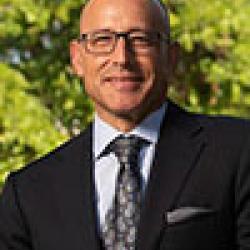Editor’s note: The opinions expressed by the author do not necessarily reflect the opinions of the AAMC or its members.
A woman with severe lupus came to a University of California (UC), Davis, Health clinic after enrolling in Medi-Cal, California’s Medicaid program. There was a long wait for a rheumatologist appointment, so she went to the emergency room and was admitted. After being stabilized and discharged, she learned she could not receive follow-up care with the medical center, as the health system no longer held a contract with her health plan. She was on her own.
I heard many stories just like this at the beginning of my tenure as vice chancellor of health and human services for UC Davis Health in 2018. The system had been operating without a Medi-Cal primary care contract for nearly three years, and it would be an understatement to say that faculty, residents, and the outside community were unhappy. (A group of faculty even published their disapproval in the October 2018 issue of Academic Medicine.)
They had good reason to be concerned that UC Davis Health wasn’t doing its part: There are nearly 500,000 Medi-Cal patients in Sacramento County, California, and from the outside it looked like we weren’t treating any of them.
In my prior leadership role as chief medical and system integration officer at the University of Miami Health System, we worked tirelessly to ensure the organization had state and federal support to maintain an open-door policy for Medicaid patients. The system was a linchpin for network adequacy and complex care across Florida. My goal was to infuse that same ethic at UC Davis Health.
First, we conducted a thorough environmental scan of UC Davis Health’s safety net activities. As predicted, there was a lot more going on than was immediately visible. Even without formal contracts in place, Medi-Cal patients made up more than 40% of discharges from the hospital. Nearly every department was providing care for underserved patients. The medical school also supported seven student-run primary care clinics that served over 5,000 patients annually.
Much of the change was to convince people that we could lend our expertise and intellectual firepower to treating the underserved in partnership with other organizations, and not go bankrupt in the process.
There were additional bright spots, like a $1.2 million annual investment in a crisis residential center for patients who do not need to be on psychiatric hold and a $4 million donation to a community nonprofit to build a posthospital discharge board and social support facility for homeless patients. UC Davis Health was also a national leader in medication for addiction treatment. Of note, much of this compassionate work was missed during routine community benefit measurement, since, like most hospitals, this is mostly reported as uncompensated care and direct charitable contributions.
Sacramento has a robust presence of federally qualified health centers (FQHCs), which have the benefit of reimbursement models that are more favorable for seeing high volumes of Medicaid patients. UC Davis Health was already contracting faculty to work at multiple FQHCs that hosted popular primary care residency rotations. In addition, there was an FQHC clinic run by Sacramento County a block down the street from our medical center that was being utilized at only about 25% of its capacity. This facility was a clear growth opportunity for our social mission of serving our immediate community, and an opportunity to implement that mission with a sustainable financial model.
First, we engaged the new head of health care services for Sacramento County, even though we had only recently emerged from a legal battle over care remittances for the uninsured. (New leadership is always an opportunity to selectively remember the past.) Talking things out might seem like a novel idea these days, but as we met over coffee and discussed our common goals from a place of good faith, we realized neither of us could make an impact alone — the county couldn’t hire enough committed physicians, and we didn’t have the right structure or funding options to see a large volume of underserved patients. It was apparent that by working together we could change the trajectory of social spending on the people who are most disadvantaged. We launched a formal partnership on February 1, 2019.
Communication is everything, and now our employees and faculty better appreciate that our social mission had never actually been abandoned, just not heralded.
During the first phase of this partnership, UC Davis Health providers are seeing anyone who needs care, mostly Medi-Cal patients and the uninsured, at the Sacramento County Health Center. Volume has increased month over month since the launch. The clinic is especially convenient for those patients who need follow up care after a visit to our emergency department (ED) down the street; sometimes, it can even replace an ED visit. The county has also bolstered resources to address social determinants of health, including increasing connection to housing, food, immigration, insurance, and other social program enrollment support within the clinic itself, a new feature based on our shared focus on directly addressing social determinants of health.
Sacramento County and UC Davis Health are also applying to be reimbursed by Medicaid for the full cost of subspecialty care delivered at the clinic. (A 2017 independent survey found that 30% of Medi-Cal patients in Sacramento County struggled to find a specialist, compared with only 20% statewide, and physicians reported having trouble with Medi-Cal referrals nearly seven times as often as with privately insured patients.) If granted permission by the U.S. Health Resources and Services Administration, this will be one of only a few federally funded clinics in the United States where patients can receive subspecialty care, integrated behavioral health, and full social service support in addition to a full slate of primary care.
Of course, part of the work has been culture change. Previously, some leaders believed that working with the underserved had to be a charitable event, as opposed to an organized effort that matches health policy trends. Much of the change was to convince people that we could lend our expertise and intellectual firepower to treating the underserved in partnership with other organizations, and not go bankrupt in the process.
July 2, 2019, will mark one year into this journey, and the building is just beginning. UC Davis Health already had tremendous capacity in telemedicine, and we’re rapidly expanding telehealth partnerships to FQHCs and rural hospitals throughout inland Northern California, with the goal of taking care of the rural underserved as well as we do the urban underserved. We’ve also invested in critical spaces such as doubling fellowships offered in child psychiatry, autism treatment, and adverse childhood experiences, in part to meet a statewide policy initiative to expand care access for children with developmental disabilities. We are opening parenting clinics for affected child caregivers, and another clinic for kids with adverse experiences, many of whom are in foster care with limited access to needed support and who have a trajectory of lifelong public expense if untreated.
Of note, the system is running well ahead of budget because this effort has clearly galvanized our team. Communication is everything, and now our employees and faculty better appreciate that our social mission had never actually been abandoned, just not heralded.
Right now, we are looking forward to the completion and publication of the 2019 community health needs assessment. Developed together with the other health systems in our area, this will help to determine our next steps, making sure we are in sync with community-identified priorities and needs.

